Livestock inventory slightly down by 2.85 percent
As of January 1, 2025, the total inventory of livestock in Leyte was estimated at 240,849 heads. This was 2.85 percent lower than the previous year’s inventory of 247,905 heads (Table 1). Swine had the highest decrease in stocks with 4.6 percent, followed by carabao with 3.30 percent. On the other hand, both cattle and goat posted increases in inventory with 4.89 percent and 10.01 percent, respectively.

Of the total swine inventory of 240,849 heads in January 2025, about 97.7 percent or 235,379 heads were raised in the smallhold farms, while only 2.3 percent or 5,470 heads were tended in the semi-commercial and commercial farms combined (Figure 1).
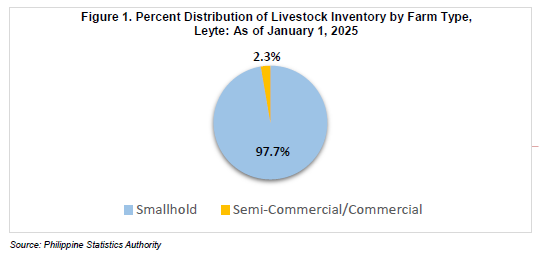
Swine accounted for the largest portion of the total livestock inventory on farms, comprising 49.6 percent (119,473 heads). Carabao followed with a 38.8 percent share (93,401 heads), while cattle made up 6.2 percent (14,918 heads) and goats contributed 5.4 percent (13,057 heads) (Figure 2).
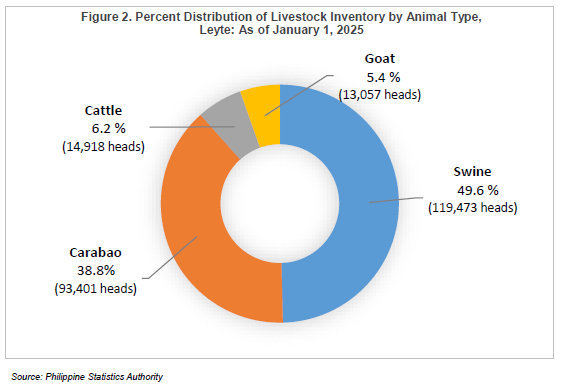
Poultry inventory expands by 9.54 percent
The total inventory of poultry in Leyte as of January 1, 2025 reached 3,354,815 birds, higher by 9.54 percent than the 3,062,768 heads recorded in the same period of 2024. This significant growth was mainly attributed to a remarkable 110.54 percent surge in gamefowl inventory, which effectively offset the 49.66 percent decline in the duck population (Table 2).
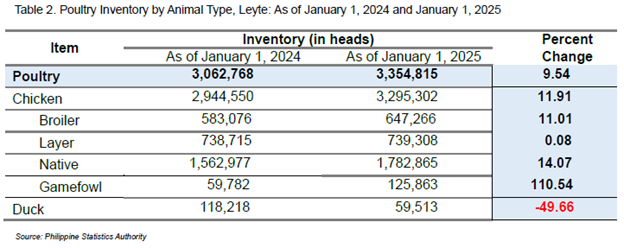
Among the type of chickens, native chickens accounted for the largest share of the total inventory, representing 54.1 percent (1,782,865 birds). Layer chickens followed with 22.5 percent (739,308 birds), while broiler chickens made up 19.6 percent (146,250 birds). Lastly, gamefowl chickens held the smallest share, comprising 3.8 percent (125,863 birds) (Figure 3).
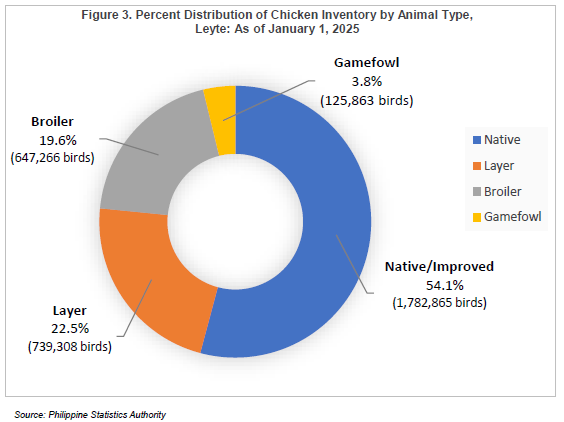
As of January 1, 2025, the total poultry inventory reached 3,354,185 birds. Of this, approximately 63.3 percent (2,124,176 birds) were raised on smallhold farms. Meanwhile, about 30.4 percent (1,018,586 birds) were tended on semi-commercial farms, and the remaining 6.3 percent (212,053 birds) were managed on commercial farms (see Figure 4).
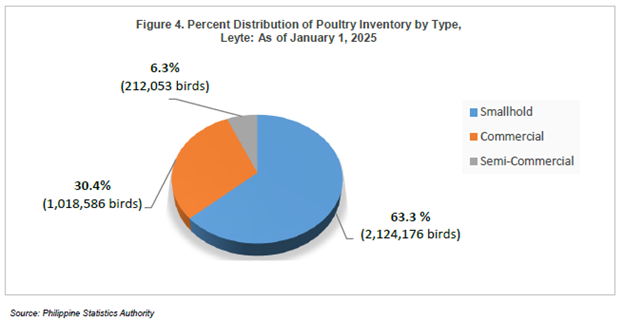
TECHNICAL NOTES
Data for this special release were taken from the two (2) major surveys, namely: a) The Backyard Livestock and Poultry Survey (BLPS) and b) The Commercial Livestock and Poultry Survey (CLPS), both conducted quarterly by the Philippine Statistics Authority (PSA).
Another source that supplements the data requirements of the Livestock and Poultry sector is the Compilation of Data Slaughterhouses and Poultry Dressing Plants (CDSPDP). This is done monthly and utilizes administrative data from Locally Registered Meat Establishments (LRMEs) in the province which is in coordination with the Provincial Veterinary Office (PVO) and Meat Inspectors (MIs) of the Local Government Unit (LGU).
The following terminologies are used in the special release:
• Smallhold Farm- is defined as follows:
1. For livestock: A farm that tends 1 to 10 animals.
2. For poultry: A farm that tends 1 to 100 layers (egg-laying hens) or 1 to 500 broilers (meat chickens).
• Semi-Commercial Farm - is defined as follows:
1. For livestock: A farm that tends 11 to 50 animals.
2. For poultry: A farm that tends 101 to 500 layers (egg-laying hens) or 501 to 1,000 broilers (meat chickens).
• Commercial Farm – is defined as follows:
1. For livestock: A farm that tends 50 or more animals.
2. For poultry: A farm that tends 500 or more layers (egg-laying hens) or 1,000 or more broilers (meat chickens)
• Swine- another term for pig or hog raised for meat purposes.
• Broiler- refers to chicken of foreign breed raised for meat purposes.
• Layer- refers to chicken of foreign breed raised for egg production.
• Native- a common backyard chicken that is a mixture of different breeds.
• Abattoirs- are facilities that are approved and registered by a controlling authority in which food animals/birds are slaughtered and dressed for human consumption.
SGD. SHERYL ANN A. JAMISOLA
Chief Statistical Specialist

